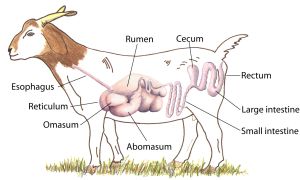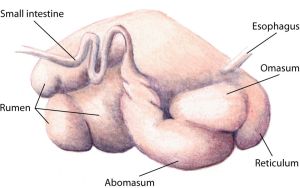The ruminant digestive system
Goats are ruminants, animals with a four-compartment stomach, as are cattle, sheep and deer. The compartments are the reticulum, rumen, omasum and abomasum, or true stomach. Monogastric or simple-stomached animals such as humans, dogs and cats consume food that undergoes acidic breakdown in the stomach and enzymatic digestion in the small intestine, where most nutrients are absorbed. In ruminants, feed first undergoes microbial digestion in the reticulum and rumen — together, often called the reticulo-rumen — prior to acidic digestion in the abomasum and enzymatic digestion and nutrient absorption in the small intestine. The microbial digestion in the reticulo-rumen allows ruminants to consume and utilize grass, hay, leaves and browse.
The reticulum and rumen form a large fermentation vat that contains microorganisms, mainly bacteria, that breakdown and digest feedstuffs, including the fibrous component of grass, forbs, and browse that cannot be digested by monogastric animals. Some of the breakdown products produced through digestion of feed by bacteria are absorbed by the animal through the rumen wall and can supply a large part of the energy needs. The rest of the byproducts of digestion, undigested feed and ruminal microorganisms flow out of the reticulo-rumen into the omasum where large feed particles are trapped for further digestion and water is reabsorbed. Material then flows into the abomasum where acidic digestion takes place and then to the small intestine for further enzymatic digestion and nutrient absorption.
The rumen provides several advantages to the goat in addition to digestion of dietary fiber. The bacteria in the rumen are capable of synthesizing all B vitamins needed. Bacteria can also synthesize protein from nitrogen recycled in the body, which may be advantageous in low protein diets. For proper ruminal function, goats require a certain level of fiber in the diet, measured as crude fiber, acid detergent fiber or neutral detergent fiber. They have bacteria in the rumen that can detoxify anti-nutritional factors like tannins. This enables goats to better utilize feedstuffs containing high tannin levels such as those found in browse. There are very few situations in which a goat will not consume adequate fiber, but they may do so when being fed a very high-grain diet. Inadequate fiber consumption can then lead to several disease conditions. The most serious disease condition is acidosis, or an extremely low pH in the rumen, causing decreased feed consumption.
When ruminants are born, the first three compartments of the stomach are underdeveloped and the stomach functions similar to that of a monogastric animal. This enables absorption of antibodies in colostrum and efficient utilization of nutrients in milk. As the young ruminant consumes solid feed, especially high in fiber, and the microbial population is established, the rumen is stimulated to develop. The rumen must have an acceptable degree of development for successful weaning.
The greatest asset goats have is the ability and tendency to utilize woody plants and weeds, not typically consumed by other species of animals like cattle and sheep, converting these plants into a saleable product. These plant species can be inexpensive sources of nutrients and make for a very profitable goat enterprise. Goats typically consume a number of different plant species in any one day and can utilize some poisonous plants because they do not consume levels high enough to be toxic. Similarly, goats are believed to have a relatively high ability to detoxify absorbed anti-nutritional factors. Goats are more resistant to bloating than other ruminants and after a brief adaptation may graze alfalfa without bloating.
Reference: Hart, S. 2008. Meat Goat Nutrition. Pages 58-83 in Proc. 23rd Ann. Goat Field Day, Langston University, Langston, OK.


